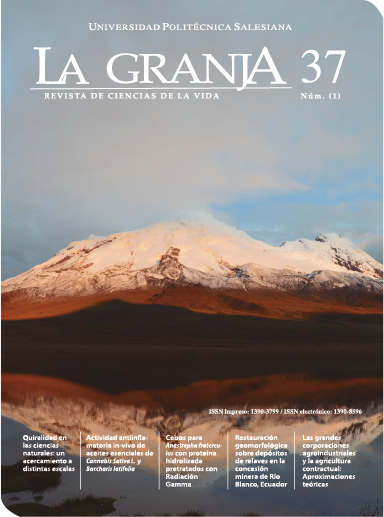Actividad antiinflamatoria in-vivo de una formulación tópica con principios activos de aceites esenciales de Cannabis sativa L. (Cáñamo) y Baccharis latifolia (Ruiz & Pav) Per. (Chilca)
Contenido principal del artículo
Resumen
Detalles del artículo

Esta obra está bajo una licencia internacional Creative Commons Atribución-NoComercial-CompartirIgual 4.0.
Universidad Politécnica Salesiana of Ecuador preserves the copyrights of the published works and will favor the reuse of the works. The works are published in the electronic edition of the journal under a Creative Commons Attribution/Noncommercial-No Derivative Works 3.0 Ecuador license: works can be copied, used, disseminated, transmitted and publicly displayed.
The undersigned author partially transfers the copyrights of this work to Universidad Politécnica Salesiana of Ecuador for the printed edition.
Referencias
Abad, M. y P. Bermejo (2007). Baccharis (Compositae): a review update. En: Arkivoc 7.7, 76-96. Online: https://bit.ly/3RHZFjo.
Adams, R. (2012). Identification of essential oils by ion trap mass spectroscopy. Academic press.
Bakir, B. y col. (2008). Investigation of the anti-inflammatory and analgesic activities of B-caryophyllene. En: International Journal of Essential Oil Therapeutics 2.1, 41-44. Online: https://bit.ly/3e9KYYP.
Brown, M., C.Worrell y C. Pariante (2021). Inflammation and early life stress: An updated review of childhood trauma and inflammatory markers in adulthood. En: Pharmacology Biochemistry and Behavior 211, 173291. Online: https://bit.ly/3fPVwfS.
Cervilla, A., F. Purriños y J. Moya (2002). Faringitis crónica y macrólidos. En: Acta Otorrinolaringológica Española 53.6, 441-443. Online: https://bit.ly/3VnVKeO.
Dahham, S. y col. (2015). In vivo anti-inflammatory activity of b-caryophyllene, evaluated by molecular imaging. En: Molecules & Medicinal Chemistry 1. Online: https://bit.ly/3TayGhu.
Di Sotto, A. y col. (2022). Phytochemical and pharmacological profiles of the essential oil from the inflorescences of the Cannabis sativa L. En: Industrial Crops and Products 183, 114980. Online: https://bit.ly/3Mmx2qS.
Golia, E. y col. (2014). Inflammation and cardiovascular disease: from pathogenesis to therapeutic target. En: Current atherosclerosis reports 16.9, 1-7. Online: https://bit.ly/3Mll6FX.
Grassmann, J. y col. (2000). Antioxidant properties of essential oils. Possible explanations for their anti inflammatory effects. En: Arzneimittelforschung 50.2, 135-139. Online: https://bit.ly/3rMJrLp.
INEC (2020). Registro Estadístico de Camas y Egresos Hospitalarios 2019. Inf. téc. 01-2020-ECEH. INEC.
Lochhead, R. y col. (2021). Lyme arthritis: linking infection, inflammation and autoimmunity. En: Nature Reviews Rheumatology 17.8, 449-461. Online: https://go.nature.com/3CzJcIG.
Malingre, T. y col. (1975). The essential oil of Cannabis sativa. En: Planta medica 28.05, 56-61. Online: https://bit.ly/3RWzUvZ.
Miguel, M. (2010). Antioxidant and anti-inflammatory activities of essential oils: a short review. En: Molecules 15.12, 9252-9287. Online: https://bit.ly/3fWDXLj.
Mortaz, E. y col. (2018). Update on neutrophil function in severe inflammation. En: Frontiers in Immunology 9, 2171. Online: https://bit.ly/3CMESpB.
Murata, M. (2018). Inflammation and cancer. En: Environmental health and preventive medicine 23.1, 1-8. Online: https://bit.ly/3EGJW1j.
Novak, J. y col. (2001). Essential oils of different cultivars of Cannabis sativa L. and their antimicrobial activity. En: Flavour and fragrance journal 16.4, 259-262. Online: https://bit.ly/3TjgGkX.
Nunes, C. y col. (2020). Plants as sources of anti-inflammatory agents. En: Molecules 25.16, 3726. Online: https://bit.ly/3RWTYye.
Oguntibeju, O. (2018). Medicinal plants with anti-inflammatory activities from selected countries and regions of Africa. En: Journal of inflammation research 11, 307. Online: https://bit.ly/3yC81Cl.
Orlando, G. y col. (2021). Comparative investigation of composition, antifungal, and anti-inflammatory effects of the essential oil from three industrial hemp varieties from Italian cultivation. En: Antibiotics 10.3, 334. Online: https://bit.ly/3Vkj2SH.
Pérez, S. y col. (2011). Anti-inflammatory activity of some essential oils. En: Journal of Essential Oil Research 23.5, 38-44. Online: https://bit.ly/3TjrGPh.
Schewe, T. (1995). Molecular actions of ebselenan antiinflammatory antioxidant. En: General Pharmacology: The Vascular System 26.6, 1153-1169. Online: https://bit.ly/3eoaOIu.
Sequeda-Castañeda, L., C. Célis y P. Luengas-Caicedo (2015). Phytochemical and therapeutic use of Baccharis latifolia (Ruiz & Pav.) pers. (Asteraceae). En: Pharmacology 2, 14-17. Online: https://bit.ly/3fRoxI8.
Shah, P. (2019). Inflammation, infection and atherosclerosis. En: Trends in cardiovascular medicine 29.8, 468-472. Online: https://bit.ly/3EEcuIM.
Surendran, S. y col. (2021). Myrcene-what are the potential health benefits of this flavouring and aroma agent? En: Frontiers in Nutrition, 400. Online: https://bit.ly/3T71p6W.
Tasneem, S. y col. (2019). Molecular pharmacology of inflammation: Medicinal plants as anti-inflammatory agents. En: Pharmacological research 139, 126-140. Online: https://bit.ly/3g6WS6o.
Urakov, A. y N. Urakova (2021). Recent insights into the management of inflammation in asthma. En: Journal of Inflammation Research 14, 4603. Online: https://bit.ly/3yzt4p8.
Valarezo, Ed. y col. (2013). Chemical composition, antifungal and antibacterial activity of the essential oil from Baccharis latifolia (Ruiz & Pav.) Pers.(Asteraceae) from Loja, Ecuador. En: Journal of essential oil research 25.3, 233-238. Online: https://bit.ly/3SSH8SO.
Van Eeden, S. y col. (2012). The relationship between lung inflammation and cardiovascular disease. En: American journal of respiratory and critical care medicine 186.1, 11-16. Online: https://bit.ly/3RUnuo3.
Winter, C., E. Risley y G. Nuss (1962). Carrageenininduced edema in hind paw of the rat as an assay for antiinflammatory drugs. En: Proceedings of the society for experimental biology and medicine 111.3, 544-547. Online: https://bit.ly/3T0jkfS.
Yatoo, M. y col. (2018). Anti-inflammatory drugs and herbs with special emphasis on herbal medicines for countering inflammatory diseases and disorders-a review. En: Recent patents on inflammation & allergy drug discovery 12.1, 39-58. Online: https://bit.ly/3ECcJ6Q.

